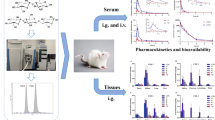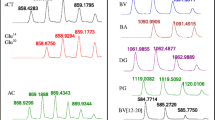Abstract
This study was performed to prepare and characterize the biotinylated Salmon calcitonin (sCT) for oral delivery and evaluate the hypocalcemic effect of biotinylated-sCTs in rats. Biotinylated sCTs was characterized by using high performance liquid chromatography (HPLC) and MALDITOF-MS. The effect of biotinylation on permeability across Caco-2 cell monolayers was examined. Their hypocalcemic effect was determined in rats. Mono- and di-bio-sCTs were separated by reverse phase HPLC. The molecular weights of mono-bio-sCT and di-bio-sCT were determined to be 3,660.5 and 3,900.2 Da, respectively. The permeability of biotinylated-sCTs across Caco-2 cell monolayers was observed with a significant enhancement compared with sCT. Intrajejunal (ij) administration of mono-bio-sCT and di-bio-sCT resulted in sustained reduction in serum calcium levels, with a maximum reduction (% max(d)) of 21.6% and 30% after 4 h and 6 h of application, respectively. The biotin conjugation of sCT may be a promising strategy for increasing the oral bioavailability of sCT and achieving sustained calcium-lowering effects.






Similar content being viewed by others
References
P. Caliceti, and F. M. Veronese. Pharmacokinetic and biodistribution properties of poly(ethylene glycol)–protein conjugates. Drug Deliv. Rev. 55:1261–1277 (2003).
K. H. Song, S. J. Chung, and C. K. Shim. Enhanced intestinal absorption of salmon calcitonin (sCT) from proliposomes containing bile salts. J. Control Release. 106:298–308 (2005).
D. H. Na, Y. S. Youn, S. D. Lee, M. W. Son, W. B. Kim, P. P. DeLuca, and K. C. Lee. Monitoring of peptide acylation inside degrading PLGA microspheres by capillary electrophoresis and MALDI-TOF mass spectrometry. J. Control Release. 92:291–299 (2003).
M. Azria. The calcitonins, Physiology and pharmacology, Karger, Basel, 1989.
K. C. Lee, M. O. Park, D. H. Na, Y. S. Youn, S. D. Lee, S. D. Yoo, H. S. Lee, and P. P. DeLuca. Intranasal delivery of PEGylated salmon calcitonins: hypocalcemic effects in rats. Calcif Tissue Int. 73:545–549 (2003).
Y. H. Lee, G. D. Leesman, V. Makhey, H. Yu, P. Hu, B. Perry, J. P. Sutyak, E. J. Wagner, L. M. Falzone, W. Stern, and P. J. Sinko. Regional oral absorption, hepatic first-pass effect, and non-linear disposition of salmon calcitonin in beagle dogs. Eur. J. Pharm. Biopharm. 50:205–211 (2000).
P. J. Sinko, C. L. Smith, L. T. McWhorter, W. Stern, E. J. Wagner, and J. P. Gilligan. Utility of pharmacodynamic measures for assessing the oral bioavailability of peptides. 1. Administration of recombinant salmon calcitonin in rats. J. Pharm. Sci. 84:1374–1378 (1995).
Y. H. Lee, and P. J. Sinko. Oral delivery of salmon calcitonin. Adv. Drug Deliv. Rev. 42:225–238 (2000).
Y. S. Youn, J. Y. Jung, S. H. Oh, S. D. Yoo, and K. C. Lee. Improved intestinal delivery of salmon calcitonin by Lys18-amine specific PEGylation: stability, permeability, pharmacokinetic behavior and in vivo hypocalcemic efficacy. J. Control Release. 114:334–342 (2006).
S. Mansoor, Y. S. Youn, and K. C. Lee. Oral delivery of mono-PEGylated sCT (Lys18) in rats: regional difference in stability and hypocalcemic effect. Pharm. Dev. Technol. 10:389–396 (2005).
J. Wang, D. Chow, H. Heiati, and W. C. Shen. Reversible lipidization for the oral delivery of salmon calcitonin. J. Control Release. 88:369–380 (2003).
C. Prego, D. Torres, and M. J. Alonso. Chitosan nanocapsules as carriers for oral peptide delivery: effect of chitosan molecular weight and type of salt on the in vitro behaviour and in vivo effectiveness. J. Nanosci. Nanotechnol. 6:2921–2928 (2006).
C. Prego, D. Torres, E. Fernandez-Megia, R. Novoa-Carballal, E. Quiñoá, and M. J. Alonso. Chitosan-PEG nanocapsules as new carriers for oral peptide delivery. Effect of chitosan pegylation degree. J. Control Release. 111:299–308 (2006).
M. Garcia-Fuentes, D. Torres, and M. J. Alonso. New surface-modified lipid nanoparticles as delivery vehicles for salmon calcitonin. Int. J. Pharm. 296:122–132 (2005).
D. Guggi, C. E. Kast, and A. Bernkop-Schnürch. In vivo evaluation of an oral salmon calcitonin-delivery system based on a thiolated chitosan carrier matrix. Pharm. Res. 20:1989–1994 (2003).
Y. H. Sang, and P. T. Gwan. Biodegradable nanoparticles containing protein-fatty acid complexes for oral delivery of salmon calcitonin. J. Pharm. Sci. 932:488–495 (2004).
K. Yamabe, Y. Kato, H. Onishi, and Y. Machida. Potentiality of double liposomes containing salmon calcitonin as an oral dosage form. J. Control Release. 89:429–436 (2003).
H. M. Said, R. Redha, and W. Nylander. A carrier-mediated, Na+ gradient dependent transport for biotin in human intestinal brush border membrane vesicles. Am. J. Physiol. 253:G631–G636 (1987).
P. D. Prasad, H. Wang, W. Huang, Y. J. Fei, F. H. Leibach, L. D. Devoe, and V. Ganapathy. Molecular and functional characterization of the intestinal Na+ dependent multivitamin tranporter. Arch. Biochem. Biophys. 366:95–106 (1999).
J. Zempleni. Uptake, localization, and noncarboxylase roles of biotin. Annu. Rev. Nutr. 25:175–196 (2005).
S. Ramanathan, S. Pooyan, S. Stein, P. D. Prasad, J. Wang, M. J. Leibowitz, V. Ganapathy, and P. J. Sinko. Targeting the sodium-dependent multivitamin transporter (SMVT) for improving the oral absorption properties of a retro-inverso Tat nonapeptide. Pharm. Res. 18:950–956 (2001).
S. Ramanathan, B. Qui, S. Pooyan, G. Zhang, S. Stein, P. D. Prasad, J. Wang, M. J. Leibowitz, and P. J. Sinko. Targeted PEG-based bioconjugates enhance the cellular uptake and transport of a HIV-1 TAT nonapeptide. J. Control Release. 77:199–212 (2001).
Y. Koda, K. Shiotani, I. Toth, Y. Tsuda, Y. Okada, and J. T. Blanchfield. Comparison of the in vitro apparent permeability and stability of opioid mimetic compounds with that of the native peptide. Bioorg. Med. Chem. Lett. 17:2043–2046 (2007).
N. S. Chatterjee, C. K. Kumar, A. Ortiz, S. A. Rubin, and H. M. Said. Molecular mechanism of the intestinal biotin transport process. Am. J. Physiol. 277:C605–C613 (1999).
S. H. Lee, S. Lee, Y. S. Youn, D. H. Na, S. Y. Chae, Y. Byun, and K. C. Lee. Synthesis, characterization, and pharmacokinetic studies of PEGylated glucagons-like peptide-1. Bioconjug. Chem. 16:377–382 (2005).
Y. S. Youn, D. H. Na, S. D. Yoo, S. C. Song, and K. C. Lee. Chromatographic separation and mass spectrometric identification of positional isomers of polyethylene glycol-modified growth hormone-releasing factor (1–29). J. Chromatogr. A. 1061:45–49 (2004).
M. Cholewinski, B. Lückel, and H. Horn. Degradation pathways, analytical characterization and formulation strategies of a peptide and a protein. Calcitonine and human growth hormone in comparison. Pharm. Acta Helv. 71:405–419 (1996).
S. D. Yoo, H. Jun, B. S. Shin, H. S. Lee, M. O. Park, P. P. Deluca, and K. C. Lee. Pharmacokinetic disposition of polyethylene glycol-modified salmon calcitonins in rats. Chem. Pharm. Bull. (Tokyo). 48:1921–1924 (2000).
S. Hirai, T. Yasbiki, and H. Mima. Effect of surfactants to nasal absorption of insulin in rats. Int. J. Pharm. 9:165–172 (1981).
P. Calceti, S. Salmaso, G. Walker, and A. Bernkop-Schnürch. Development and in vivo evaluation of an oral insulin–PEG delivery system. Eur. J. Pharm. Sci. 22:315–323 (2004).
R. I. Mahato, A. S. Narang, L. Thoma, and D. D. Miller. Emerging trends in oral delivery of peptide and protein drugs. Crit. Rev. Ther. Drug Carr. Syst. 20:153–214 (2003).
R. B. Shah, and M. A. Khan. Protection of salmon calcitonin breakdown with serine proteases by various ovomucoid species for oral drug delivery. J. Pharm. Sci. 93:392–406 (2004).
R. B. Shah, and M. A. Khan. Regional permeability of salmon calcitonin in isolated rat gastrointestinal tracts: transport mechanism using Caco-2 Cell monolayer. AAPS J. 6:1–5 (2004).
S. Y. Chae, C. H. Jin, H. J. Shin, Y. S. Youn, S. Lee, and K. C. Lee. Preparation, characterization, and application of biotinylated and biotin-PEGylated glucagon-like peptide-1 analogues for enhanced oral delivery. Bioconjug. Chem. 19:334–341 (2008).
S. el-Khafagy, M. Morishita, Y. Onuki, and K. Takayama. Current challenges in non-invasive insulin delivery systems: a comparative review. Adv. Drug Deliv. Rev. 5915:1521–1546 (2007).
Author information
Authors and Affiliations
Corresponding author
Rights and permissions
About this article
Cite this article
Cetin, M., Youn, Y.S., Capan, Y. et al. Preparation and Characterization of Salmon Calcitonin–biotin Conjugates. AAPS PharmSciTech 9, 1191–1197 (2008). https://doi.org/10.1208/s12249-008-9165-2
Received:
Accepted:
Published:
Issue Date:
DOI: https://doi.org/10.1208/s12249-008-9165-2




